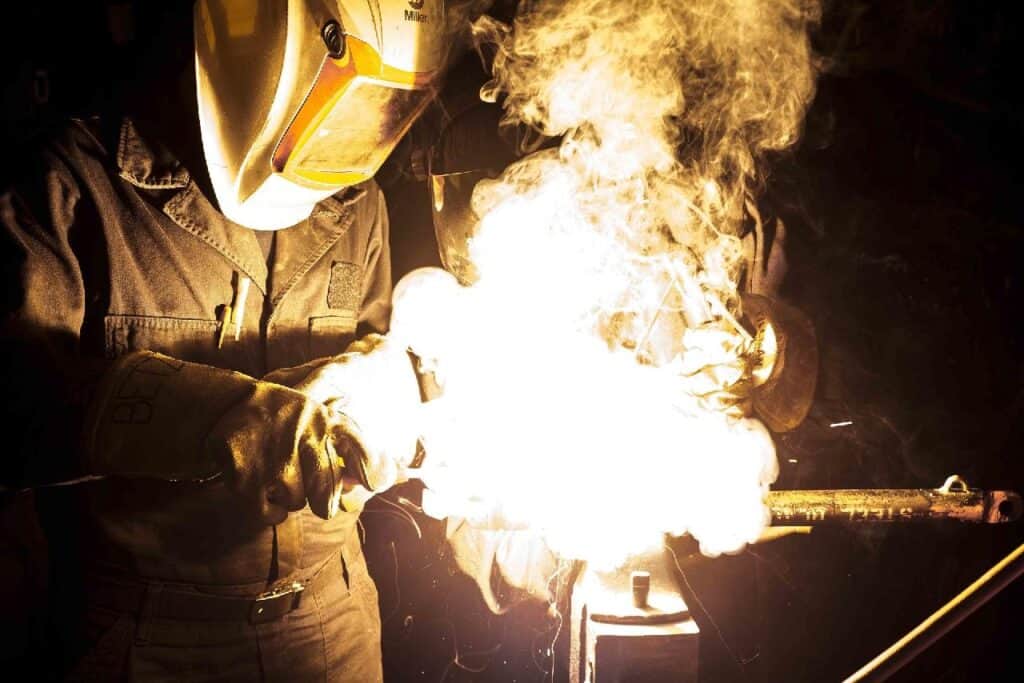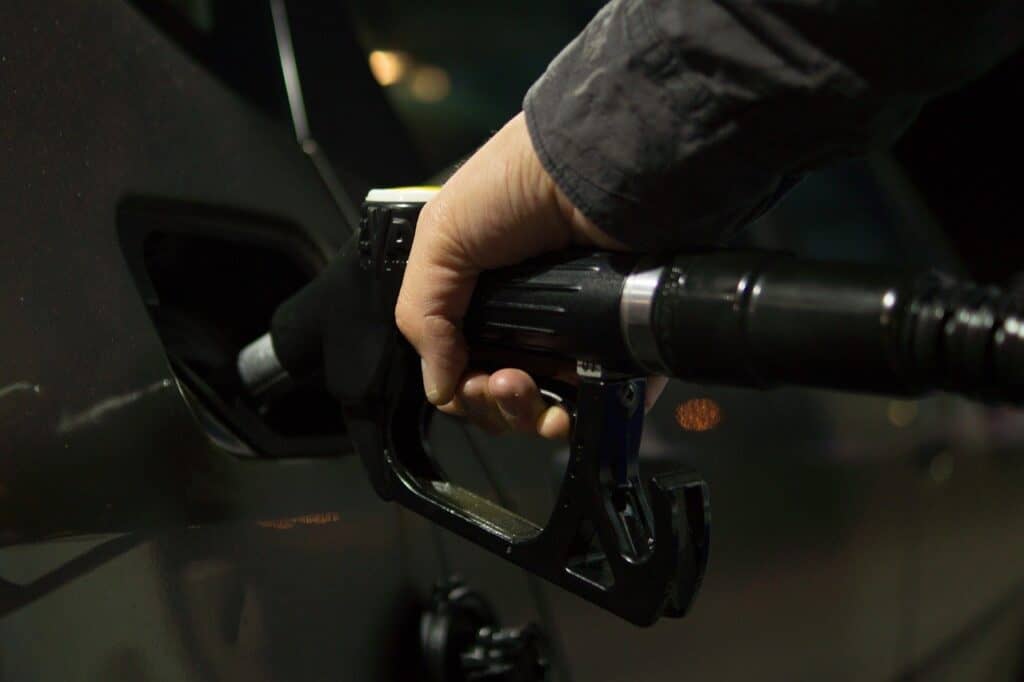Most of us have experimented with magnesium at school or college. It’s a very memorable experiment that involves taking a tiny piece of magnesium wire and setting fire to it. It’s memorable because the flame produced is so bright that it’s almost blinding. But does the brightness of the flame mean that magnesium is a flammable material and if so, is it hazardous in any way?
Magnesium can catch fire with enough heat and burn very intensely. It is also a difficult type of fire to extinguish. Magnesium is solid at room temperature, and it will ignite at temperatures of around 630 degrees Celsius or 1166 degrees Fahrenheit.
Magnesium and fire can present some unique challenges. Let’s take a closer look at some of these issues.
Your # 1 priority is keeping your family safe. As a firefighter, I recommend everyone has updated smoke detectors that don’t require battery changes, like these ones from Kidde, a fire extinguisher, like this one from Amerex, and a fire escape ladder if you have bedrooms above the first floor, I recommend this one from Hausse.
Also read: What Makes Something Flammable?
What Is Magnesium?

Magnesium is a metallic element that in its pure form comes as a shiny gray solid.
It’s produced by dying stars as carbon and helium nuclei fuse together.
When these stars explode (go supernova) the magnesium is hurled out across the galaxies.
On Earth, Magnesium is the 8th most abundant element in the crust and the fourth most common element in the Earth.
About 13% of Earth’s mass is magnesium and it is even the third most common element in seawater thanks to the solubility of magnesium compounds.
As it is highly reactive, magnesium is never found as a pure metal and always as a compound, and to get the metal, it must be extracted, usually from seawater using electrolysis.
Its main industrial use is in aluminum-magnesium alloys which are both lightweight and strong.
Magnesium is also essential to human life and is an active participant in all our cells and many of the enzymes used to facilitate our metabolic processes.
You may also find magnesium salts used in medicines, particularly as laxatives and to calm nervous conditions.
Also read: Does Metal Burn In A Fire? Examined
Is Magnesium Flammable?
Strictly speaking, magnesium is highly combustible and not flammable.
Magnesium will catch fire without a huge amount of effort and this is particularly true of the powdered form of Magnesium which will light so easily that it may be considered flammable.
It is important to realize that as with all powders, the surface area to volume ratio is hugely increased compared to a solid form of Magnesium.
As magnesium burns well and releases a lot of heat and light as part of the reaction, this means that magnesium powder is also an explosion risk.
If you work with magnesium powder or dust, it is essential that you familiarize yourself with the material safety data sheet and take all the precautions laid out on it.
Also read: Is Iron Flammable? Sometimes…
Take a look at why magnesium fires can be so dangerous:
Does It Ignite Easily?
While magnesium is not, strictly speaking flammable, except as a powder, it does ignite very easily and a lighter flame or a gas flame are enough to get it to ignite.
Once magnesium is lit, the amount of heat and light put out by the burning reaction means that it is a self-sustaining reaction and will need to be extinguished manually if you do not want all the magnesium to be consumed.
The magnesium flame is very hot and can reach up to 5,610 degrees Fahrenheit (3100 Celsius) and great care must be taken to avoid burns when using burning magnesium.
Also read: Is Lithium Flammable? Battery Explosions
Can It Spontaneously Combust?
While magnesium burns fairly easily, it does not spontaneously combust until it reaches temperatures of over 1,000 degrees Fahrenheit, which means it won’t spontaneously combust in the lab unless it’s exposed to a fire of some description.
What Happens When You Put Magnesium In A Fire?
When magnesium is set on fire, it burns with a blinding white light and releases a large amount of heat.
The end product of burning magnesium in the air is magnesium oxide. MgO.
Is It Safe To Burn Magnesium?
Burning magnesium can be safe as long as you take the right safety precautions.
The bright light and intense heat produced are definitely safety risks, otherwise.
How Quickly Does It Burn?
Magnesium is quickly consumed when burning and nearly 10% of the energy created is output as light.
The exact time it takes to burn depends on how much magnesium you have and what form it is in when it is being burned.
Powder burns faster than magnesium ribbon which in turn burns faster than a solid lump of magnesium would.
Also read: Is Gold Flammable? Surprising Answer…
Is Magnesium Flammable With Water?
Magnesium reacts strongly with water.
In fact, magnesium powder requires no heat at all to form magnesium hydroxide and hydrogen when dumped into the water.
However, it is also true that burning magnesium will not be extinguished by water and will, in fact, burn in water.
This is because it reacts with the oxygen in the water to produce other chemical end products.
Does Magnesium Burn Hotter In Ice?
If you’ve ever seen the classic TV show, Lost in Space, then you may have seen the episode in which Will Robinson asserts that burning magnesium in ice makes the flame hotter and they use this trick to get Judy free of some ice she’s been caught in.
But is this true?
Well, yes, it is.
We’ve already established that magnesium burns in water and that you can’t put out a magnesium fire with water.
And it also burns hotter with water than it does by itself.
Will Robinson’s logic is sound, burning magnesium and ice together is hotter than burning magnesium on its own.
Can Magnesium Burn Through Steel?
Yes, magnesium is often used as a fuse to set other metals alight because it catches fire at relatively low temperatures but then goes on to burn very hot, hot enough to set metals alight that won’t catch fire easily with a naked flame.
How Do You Extinguish A Magnesium Fire?
The best way to extinguish a magnesium fire is to use a class D fire extinguisher which has been designed to extinguish the fires made by combustible metals (so you can also use it with titanium or sodium fires, for example).
If there’s no class D extinguisher to hand, then smothering the fire in sand is also a good way to extinguish the fire.
Don’t, whatever you do, add water. That’s a recipe for a much stronger fire.
What Temperature Does It Melt At?
Magnesium melts at about 1,202 degrees Fahrenheit or 650 degrees Celsius.
In most cases, it will ignite before it melts and molten magnesium is something that would need to be made under strict conditions in a lab.
Safety Precautions With Magnesium
You should wear safety glasses when working with magnesium and should never look directly into the burning flame.
Looking at the bright light of burning magnesium can leave you temporarily blind and it is possible that if this was done on a regular basis that it might permanently damage your vision too.
You should also wear gloves that are impermeable and fire-resistant as well as protective work clothing.
In addition, it’s important that the area you work in is well-ventilated, that no one smokes around the area, and that you don’t eat in the same area as you work.
We’d also note that if your work creates magnesium dust it is imperative that you do not use any cleaning equipment (and this includes compressed air) that could cause an electric spark and, in turn, cause an explosion.
Is Magnesium Dust Toxic?
Magnesium itself is non-toxic.
It’s in your body right now, in fact.
But magnesium oxide, the byproduct of burning magnesium, can be toxic if inhaled.
It produces “metal fume fever” which has symptoms very similar to the flu.
You get a headache, fever, chills, cough, and tightness in your chest and unlike flu, you also may find that you have a sort of metal taste in your mouth too.
The good news is that this condition is not fatal and after 2-3 days the symptoms will alleviate by themselves.
The long-term effects of inhaling magnesium, however, are unknown.
Why Do You Need To Clean Magnesium Ribbon Before Burning It?
Because magnesium is highly reactive, magnesium ribbon, when stored for any length of time, ends up with impurities on the surface (mainly magnesium oxide) and if you try to burn the ribbon with this in place, it won’t burn as it is supposed to.
The way to ensure that the magnesium burns properly is to sand the surface down and remove the impurities.
How Do You Dispose of Magnesium Safely?
Because magnesium powder is both flammable and an explosive hazard, to dispose of it safely you will need to consult your local (as well as state and federal) regulations to determine the legal disposal methodology for you.
Under no circumstances should magnesium be dumped in the regular trash.
Sources
1, 2, 3, 4, 5, 6, 7, 8, 9, 10, 11, 12, 13, 14

